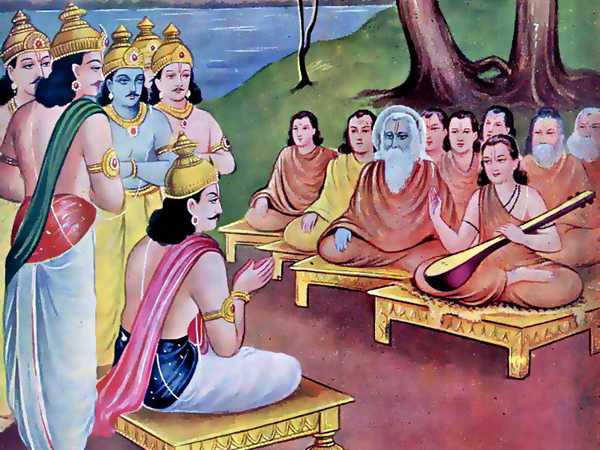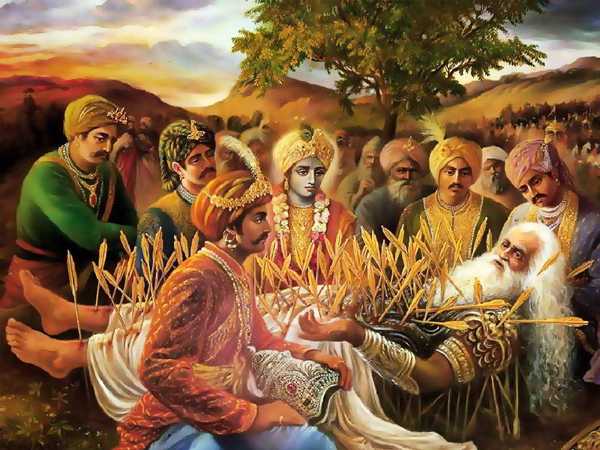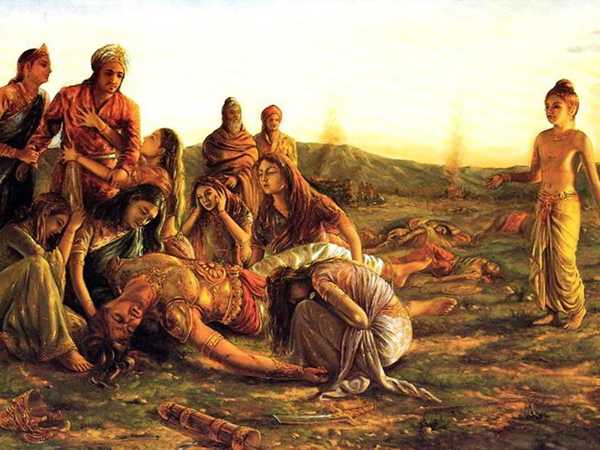Chapter 303

“Yudhishthira said, ‘What is that which is called Undeteriorating and byattaining to which no one has to come back? What, again, is that which iscalled Deteriorating, and by attaining to which one has to return oncemore? O slayer of foes, I ask thee the distinction that exists, O thou ofmighty arms, between the Deteriorating and the Undeteriorating ones forunderstanding them both truly, O delighter of the Kurus, Brahmanasconversant with the Vedas speak of thee as an Ocean of knowledge.Highly-blessed Rishis and Yatis of high souls do the same. Thou hast veryfew days to live. When the Sun turns from the southern path for enteringinto the northern, thou shalt attain to thy high end. When thou shaltleave us, from whom shall we hear of all that is beneficial for us? Thouart the lamp of Kuru’s race. Indeed thou art always blazing with thelight of knowledge. O perpetuator of Kuru’s race, I desire, therefore tohear all this from thee. Listening to thy discourses that are alwayssweet like nectar, my curiosity, without being satiated is alwaysincreasing!’
“Bhishma said, ‘I shall, in this connection, relate to thee the oldnarrative of the discourse that took place between Vasishtha and kingKarala of Janaka’s race. Once on a time when that foremost of Rishis,viz., Vasishtha, endued with the effulgence of the Sun, was seated at hisease, king Janaka asked him about that highest knowledge which is for oursupreme good. Highly proficient in that department of knowledge which isconcerned with the Soul and possessed of certain conclusions in respectof all branches of that science,[1608] as Maitravaruni, that foremost ofRishis, was seated the king approaching him with joined hands, asked himin humble words, well pronounced and sweet and destitute of allcontroversial spirit, the question,–O holy one, I desire to hear, ofSupreme and Eternal Brahma by attaining to which men of wisdom have notto come back. I desire also to know that which is called Destructible andThat into which this universe enters when destroyed. Indeed, what is Thatwhich is said to be indestructible, suspicious, beneficial and free fromevil of every kind?
“Vasishtha said, Hear, O lord of Earth, as to haw this universe isdestroyed, and, of That which was never destroyed and which will never bedestroyed at any time. Twelve thousand years, (according to the measureof the celestials), make a Yuga, four such Yugas taken a thousand times,make a Kalpa which measures one day of Brahman.[1609] Brahman’s nightalso, O king, is of the same measure. When Brahman himself isdestroyed[1610]. Sambhu of formless soul and to whom the Yuga attributesof Anima, Laghima, &c, naturally inhere, awakes, and once more createsthat First or Eldest of all creatures, possessed of vast proportions ofinfinite deeds, endued with form, and identifiable with the universe.That Sambhu is otherwise called Isana (the lord of everything). He ispure Effulgence, and transcends all deterioration, having his hands andfeet stretching in all directions, with eyes and head and moutheverywhere, and with ears also in every place. That Being exists,overwhelming the entire universe. The eldest-born Being is calledHiranyagarbha. This holy one has (in the Vedanta) been called theUnderstanding. In the Yuga scriptures He is called the Great, andVirinchi, and the Unborn. In the Sankhya scriptures, He is indicated bydiverse name, and regarded as having Infinity for his Soul. Of diverseforms and constituting the soul of the universe. He is regarded as Oneand Indestructible. The three worlds of infinite ingredients have beencreated by Him without assistance from any source and have beenoverwhelmed by him. In consequence of His manifold forms, He is said tobe of universal form. Undergoing modifications He creates Himself byHimself. Endued with mighty energy, He first creates Consciousness andthat Great Being called Prajapati endued with Consciousness. The Manifest(or Hiranyagarbha) is created from the Unmanifest. This is called by thelearned the Creation of Knowledge. The creation of Mahan (or Virat) andConsciousness, by Hiranyagarbha, is the creation of Ignorance.[1611]Ascription of attributes (worthy of worship) and the destruction thereof,called respectively by the names of Ignorance and Knowledge by personslearned by the interpretation of the Srutis, then arose, referring tothis, that, or the other of the three (viz., Akshara, Hiranyagarbha, orVirat).[1612] Know, O king, that the creation of the (subtile) elementsfrom consciousness is the third.[1613] In all kinds of consciousness isthe fourth creation which flows modification of the third. This fourthcreation comprises Wind and Light and Space and Water and Earth, withtheir properties of sound, touch, form, taste and scent. This aggregateof ten arose, without doubt, at the same time. The fifth creation, Omonarch, is that which has arisen from combination of the primal elements(named above). This comprises the ear, the skin, the eyes, the tongue,and the nose forming the fifth, and speech, and the two hands, and thetwo legs, and the lower duct, and the organs of generation. The firstfive of these constitute the organs of knowledge, and the last five theorgans of action. All these, with mind, arose simultaneously O king.These constitute the four and twenty topics that exist in the forms ofall living creatures. By understanding these properly, Brahmanaspossessed of insight into the truth have never to yield to sorrow. In thethree worlds a combination of these, called body, is possessed by allembodied creatures. Indeed, O king a combination of those is known assuch in deities and men and Danavas, and Yakshas and spirits andGandharvas and Kinnaras and great snakes, and Charanas and Pisachas, incelestial Rishis and Rakshasas, in biting flies, and worms, and gnats,and vermin born of filth and rats, and dogs and Swapakas and Chaineyasand Chandalas and Pukkasas in elephants and steeds and asses and tigers,and trees and kine. Whatever other creatures exist in water or space oron earth, for there is no other place in which creatures exist as we haveheard, have this combination. All these, O sire, included within theclass called Manifest, are seen to be destroyed day after day. Hence, allcreatures produced by union of these four and twenty are said to bedestructible.
“This then is the Indestructible. And since the universe, which is madeup of Manifest and Unmanifest, meet with destruction, therefore, it issaid to be Destructible. The very Being called Mahan who is theeldest-born is always spoken of as an instance of the Destructible. Ihave now told thee, O monarch, all that thou hadst asked me. Transcendingthe four and twenty topics already adverted to is the twenty-fifth calledVishnu. That Vishnu in consequence of the absence of all attributes, isnot a topic (of knowledge) though as then which pervades all the topics,he has been called so by the wise. Since that which is destructible hascaused all this that is Manifest, therefore, all this is endued withform. The twenty-fourth, which is Prakriti, is said to preside over allthis (which has sprung from her modifications). The twenty-fifth, whichis Vishnu, is formless and, therefore, cannot be said to preside over theuniverse.[1614] It is that Unmanifest (Prakriti), which, when endued withbody (in consequence of union with Chit) dwells in the hearts of allcreatures endued with body. As regards eternal Chetana (theIndestructible), although he is without attributes and without form, yethe (in consequence of a union with Prakriti) assumes all forms. Unitingwith Prakriti which has the attributes of birth and death, he alsoassumes the attributes of birth and death. And in consequence of suchunion he becomes an object of perception and though in reality divestedof all attributes yet he comes to be invested therewith. It is in thisway that the Mahan-Soul (Hiranyagarbha), becoming united with Prakritiand invested with Ignorance, undergoes modifications and becomesconscious of Self. Uniting with the attributes of Sattwa and Rajas andTamas, he becomes identified with diverse creatures belonging to diverseorders of Being, in consequence of his forgetfulness and his waiting uponIgnorance. In consequence of his birth and destruction arising from thefact of his dwelling in upon with Prakriti, he thinks himself to be noother than what he apparently is. Regarding himself as this or that, hefollows the attributes of Sattwa, Rajas, and Tamas. Under the influenceof Tamas, he attains to diverse kinds of conditions that are affected byTamas. Under the influence of Rajas and Sattwa, he attains similarly toconditions that are affected by Rajas and Sattwa. There are three coloursin all, viz., White, Red, and Dark. All those colours appertain toPrakriti (so that He it is who becomes White or Red or Dark according asthe nature of the Prakriti with which is He becomes identified for thetime being). Through Tamas one goes to hell. Through Rajas one attains toand remains in the status of humanity. Through Sattwa, people ascend tothe regions of the deities and become sharers of great felicity. Byadhering to sin continuously one sinks into the intermediate order ofbeings. By acting both righteously and sinfully one attains to the statusof the deities. In this way the twenty-fifth, viz., Akshara (theIndestructible), the wise say, by union with the unmanifest (Prakriti),becomes transformed into Kshara (destructible). By means of knowledgehowever, the Indestructible becomes displayed in His true nature–“



